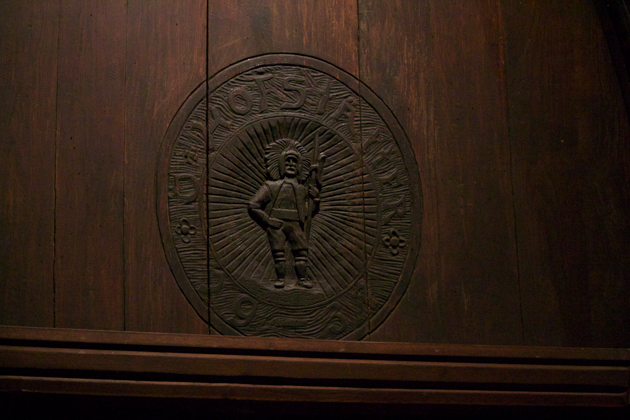
A Saltner etched on to a Hofstatter barrel
Hofstätter is located in a 15th century building founded as an inn by Joseph Hofstatter in the town of Tramin (Termeno) in Alto Adige. This is the Germanic part of Italy and Tramin looks more like Austria. The inhabitants speak German first then Italian and Ladinish.
Hofstätter wine was originally produced from the inn’s mountain-side vineyards in order to supply the inn. In 1907 they started producing wine more seriously but were not selling it in bottles until the 1960’s as the bottles were more expensive than the wine. Today the fourth generation of the family is producing wine focused on traditional local grape varieties such as Gewürztraminer, Lagrein, Schiava and Pinot Blanc. They are particularly noted for their exceptional Pinot Bianco and Pinot Nero.Nicholas Belfrage states that J. Hofstätter is, “one of the world’s best Pinot Noir producers outside Burgandy.”
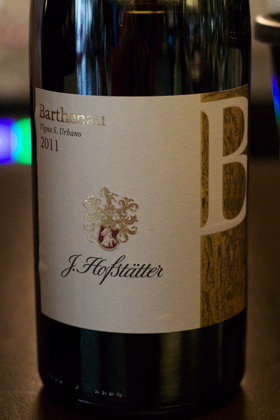
J Hofstätter, Barthenau Vigna S Urbano 1995 Alto Adige
Hofstätter is one of the largest and best wineries in Alto Adige and produces 700,000 bottles a year from their 50 hectares of vineyard plus they purchase grapes from another 50 hectares of vineyard. Buying grapes requires a good longstanding relationship with the growers to ensure that the grapes are grown in accordance with J. Hofstätter’s requirements. Markus explains that 10,000 kilos of grapes are grown per hectare and it takes 1.5 kilos of grapes to make a litre of wine. There has been a shift over time towards more white grape varietals (now 60% from 10%) than red grape varietals.
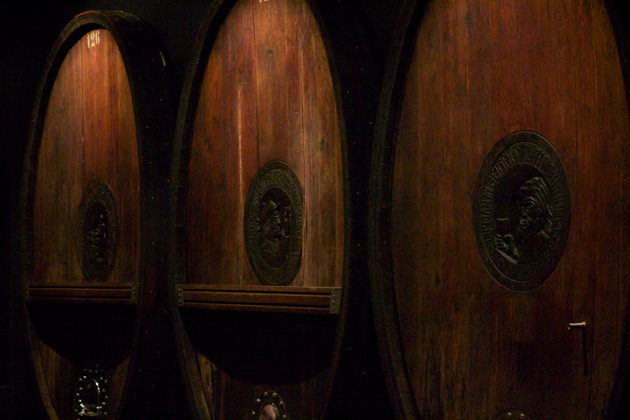
Large traditional barrels
The winery itself is an interesting mixture of innovation and tradition. We were given a tour by Markus Heinel, the winemaker at J. Hofstätter. He is clearly a very thoughtful person and serious about his wine. His thinking is the embodiment of the ethos of J. Hofstätter. He thinks of his wine from every angle- innovation, tradition, astronomy, electromagnetics and history.
The Vineyard
In the vineyard, J. Hofstätter has embraced the Guyot method of growing. J. Hofstätter ‘s oldest vines (about 15% of the total) are still grown on pergola. Some of the varieties like the local Lagrein are suited to this method. While the pergola trentina is the traditional method in this area, it was traditionally used to maximise the use of the land so that animals could walk under the vines and vegetables could be grown underneath. Nowadays local agriculture is less diversified, concentrating on grapes and apples.
Markus explains the problem of growing vines with the pergola system by using the analogy of driving with the gas and the brake pedal at the same time (the pergola method results in a high volume of low quality wine which must be cut frequently to keep the quantity down and bring the quality up). The other problem with the pergola method is that when the weather is hot and it rains, the vines creating the canopy act as a roof, keeping in the heat and humidity, fostering mould (requiring spraying to keep under control). The Guyot gives them more control over the yield and does not need to be sprayed or cut as often.
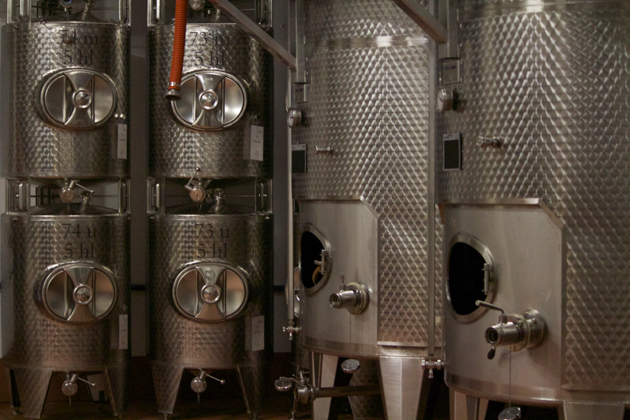
Stainless steel tanks
The Winery
Markus explained his view on winemaking was that wine should be thought of primarily as a fermentation. The process of the fermentation and all the materials used that affects the fermentation should be taken into consideration. For this reason he does not overly focus on the oak using the analogy of a dress, that the oak is the dress which can change style (modern or traditional) but the character and personality is the wine itself and this comes from the parcel of land and the vintage.
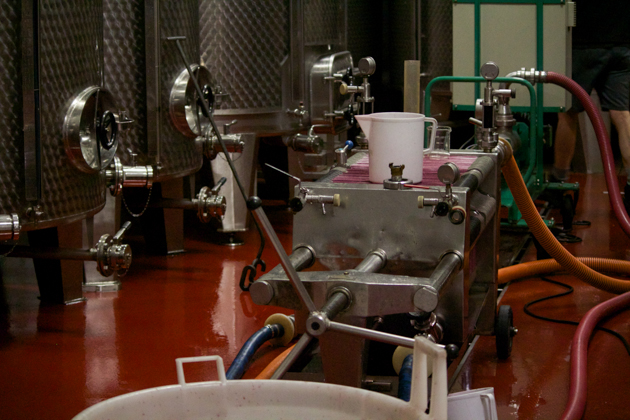
Filtering the wine
The tank room appears like a standard row of steel tanks. The whites are matured in the steel tanks (although the single estate Pinot Bianco is matured in wood). We stop in front of a doorway and when we enter we find huge potbellied concrete tanks lining the walls. Markus explains that there are theories that the steel tanks have electromagnetic properties that disturb the wine whereas cement and wood are neutral. The concrete naturally cools the wine and the shape of the concrete tank encourages the wine to settle itself as the solids float naturally while the liquid sinks. The wine then requires less fining if it matures in concrete tanks. He believes that the concrete matured wine is smoother and requires less time aging in oak. Concrete’s other benefits are that it is porous (allowing the wine to breathe), neutral in taste and is energy efficient.
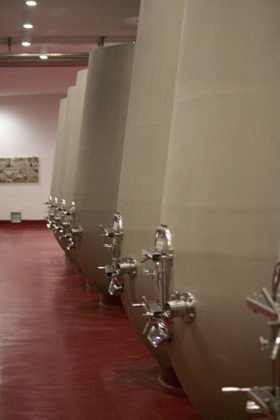
The concrete tanks
The Saltner
We started the tour in a room filled with huge, antique wooden barrels with carvings etched into them. One of the carvings was of a Saltner which could refer to either a shepherd or a guardian of the vineyard. The term Saltner is derived from the Latin word, “saltus” which means “place for pasture” and dates back more than 600 years. The Saltners that guarded the vineyards had were considered mysterious figures (and sex symbols, similar to American cowboys) and existed up until the First World War. They had special rights including the right to enter the church armed, a right not even Napoleon revoked. However, they were not allowed to marry so girls were warned to stay away from them. Saltners were paid a schüttelbrot (crispy flat rye bread) for every animal they watched. If they were not paid they would pretend to not know where the animal was until they were given a schüttelbrot to bring it back. Every winery employed one or two of them to guard the vineyards from animals and thieves. They had the authority to shoot to kill (with the exception of pregnant women who were allowed to eat whatever grapes they wanted).
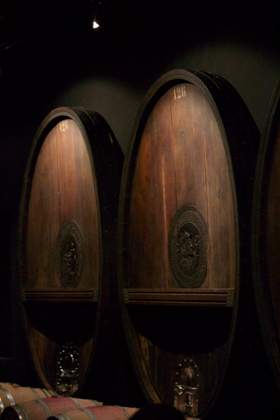
The large wooden barrels
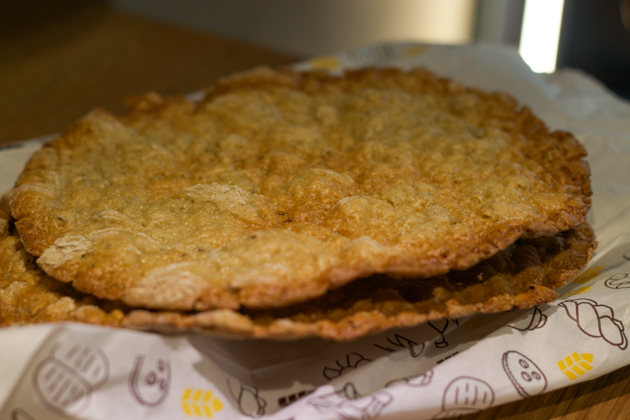
Schüttelbrot
There are few remaining Saltners today whose work is primarily as shepherds, their work of diminishing importance with the extinction of local bears and wolves. They are mainly a tourist attraction distinguished by their black hat with a large feather adorning it.
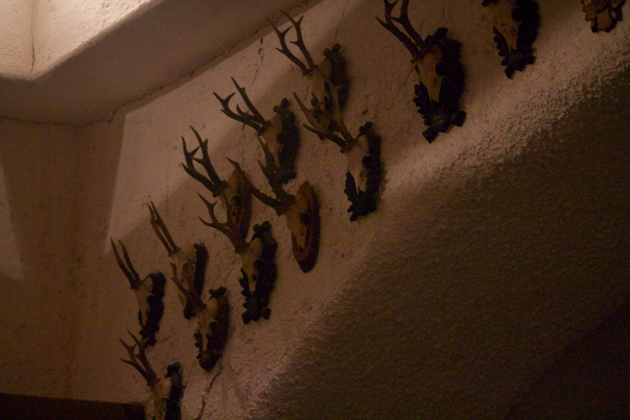
Deer antlers adorning the walls of the large barrel room
We were given this story about the Saltners which highlights the tradition of using local mountain herbs for medicinal purposes which continues today:
“The Moidl of Piz da Uridl
The shepherd of Saltria, already in his later years and no longer in good health, was on his way from the turning near the Sassolungo through the forest at Cunfin walking in the moonlit night, when just as he reached the lush pastures of the “Grosse Prise“, he came across an old woman. The shepherd paused and asked the old lady what she was doing at such a late hour in that desolate and uninhabited area. The old woman did not answer and continued unperturbed on her way.
The shepherd felt uneasy and even suspected that this might have been a spirit. It had to be the Moidl of Piz da Uridl. After all, he had heard that at night, she ran around in search of medicinal herbs under the full moon. He watched the old woman while she was picking arnica. By the time she had collected a large tuft she suddenly disappeared into the woods. What would a spirit do with all that arnica, asked the shepherd and continued in his way back home.
Returning to his mountain pasture, he opened the door, walked into the kitchen and looked around for a match with which to light a candle. As soon as the flame was lit he noticed there was a bottle of arnica grappa on the table. This must be the work of the Moidl, he thought.
However, since he did not know the healing effects of arnica, he immediately felt like swigging down a mouthful. Only the creak of the door prevented him from doing so. There she was, the Moidl of Piz da Uridl, standing right in front of him. “Do not drink it! Rub it on, you fool!” Then she disappeared again just as suddenly.
It was in this way, that the shepherd found a powerful remedy for his ailments and was able to continue his work for many years to come on the Siusi high Alpine pasture.”
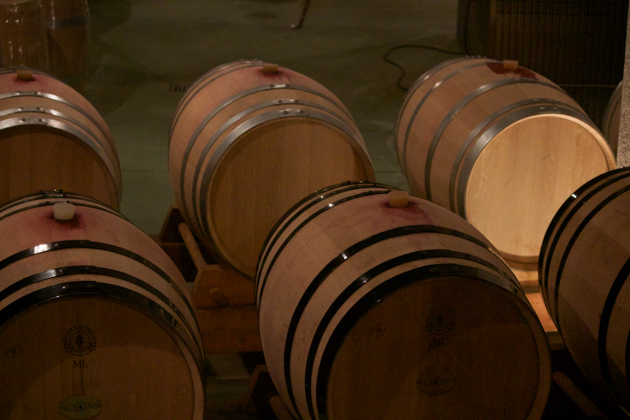
The barrels
The Cellar
Markus then gives us an interesting history lesson on why French barrels have historically been the best. Louis XIV was making plans to invade England but needed to build boats. In order to build the masts they needed long straight trees without branches. They planted oak trees and ensured no branches grew. These trees are perfect for making barrels as no branches means no knots in the wood. The French command a premium for their barrels which sell for €700 to 1,000 each.
J. Hofstätter uses the barrels 3 to 4 times before discarding them. Markus travels to France to meet with the coopers and accompanies them to rate and select which trees will make their barrels. In the cellar, the barrels are lined up in neat rows, organised by parcel of land.
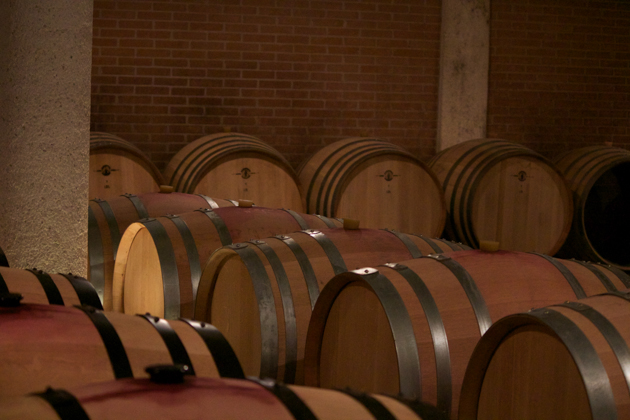
The barrels lined up by parcel of land (see the glass sided barrel at the far right)
One of the barrels has a glass side. Markus is studying the validity of a biodynamic theory that wine becomes more turbid with full moons.
The wines will mature in oak for 12 to 16 months. After this the wine will be moved to the huge wooden barrels like the one engraved with the Saltner for a total of 2 years (including the French oak maturation time). Then the wine is bottled and sits for 6 months before being sold.
The Wines
Note: Labelling “Vigna” in Alto Adige means the grapes in the wine are grown in a single vineyard and is equivalent to “Cru” in French.
White wine:
De Vite
Made from Pinot Blanc, Müller Thurgau, Sauvignon Blanc and Riesling grapes.
Pairing: seafood, white meat and poultry.
Pinot Blanc
Pairing: Appetisers, fish dishes, broths and vegetable soups.
Barthenau Vigna San Michele, Alto Adige
Made from Pinot Blanc grapes grown in the single vineyard, Vigna San Michele, in the Barthenau vineyard in Mazon. They are aged in large oak casks for 12 months.
Tasting notes: Jancis Robinson on the 2010 vintage tasted in 2012, “Attractive lift. Rather buttery. But with freshness. Herby. Interesting. Mouth filling. Alpine fresh. Long.”
Timing: Drink within 5 years
Pairing: Fish dishes, shellfish and crustaceans, white meats and poultry.
Rating: Jancis Robinson 16.5/20
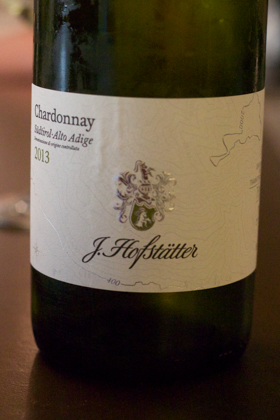
Chardonnay
Chardonnay
Pairing: Appetisers, pasta dishes and fish.
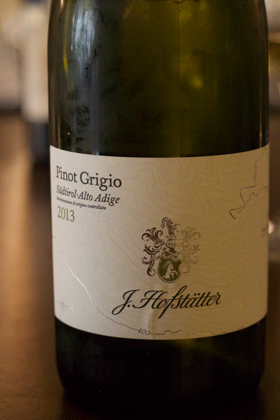
Pinot Grigio
Pinot Grigio
Pairing: Dishes based on egg, fish appetisers, vegetable soups.
Müller Thurgau
Pairing: First courses, white meats, salads and grilled vegetables.
Gewürztraminer:
They produce 350,000 bottles of Gewürztraminer per year.
Joseph Gewürztraminer Alto Adige
Made from 100% Gewürztraminer grapes which have been aged on the lees for 8 months.
Tasting notes: Jancis Robinson on the 2012 vintage tasted in 2013, “Smoky, lightly savoury nose. Low key but attractively floral (roses?). Nicely balanced. Muted in a good way!”
Timing: drink within 3 years
Pairing: On its own as an aperitif, with shellfish, goose liver and gorgonzola cheese.
Rating: Jancis Robinson 16/20
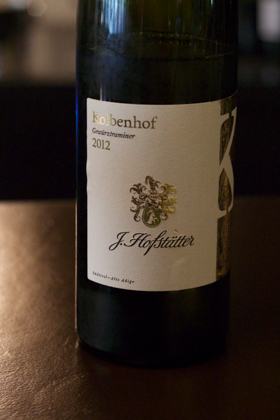
Kolbenhof Gewürztraminer
Kolbenhof Gewürztraminer
Made from 100% Gewürztraminer grapes from the Kolbenhof vineyard which have been aged on the lees for 8 months.
Timing: drink within 10 years.
Pairing: shellfish, oysters or foie gras, sophisticated fish dishes.
Rose wine:
Joseph Rosé Alto Adige
Made of 100% Lagrein grapes.
Tasting notes: Jancis Robinson on the 2013 vintage tasted in 2014, “Deeply coloured. Rich in red fruit. Super dry, full fruited and with alpine freshness. Tight and just lightly tannic. Mouthwatering finish. (JH)”
Pairing: Appetisers, smoked fish, white meats and bollito misto (mixed boiled meats).
Timing: drink within 3 years
Rating: Jancis Robinson 16.5/20
Red wine:
Lagrein:
Kolbenhofer
Made from Lagrein and Schiava grapes.
Pairing: roasts, poultry, pork chops and barbecued pork.
Lagrein Alto Adige
Tasting notes: Jancis Robinson on the 2011 vintage tasted in 2013, “Deep smudgy black cherry colour. Spicy and rich dark berry fruit – more wild berry than cassis. Firm and dry in the mouth but the fruit escapes those tannins in exuberant style with a fine bite of freshness on the finish. Mouthwatering and tangy. (JH)”
Pairing: Red meats, game, venison and seasoned cheeses.
Timing: drink within 5 years, it becomes fruitier as it ages
Rating: Jancis Robinson 16.5/20
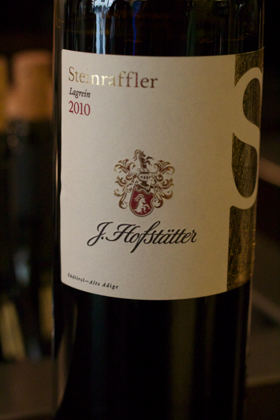
Steinraffler Lagrein
Steinraffler Lagrein
Made from Lagrein grapes aged in small oak barrels for 15 months and then in large oak casks for a further 7 months.
Pairing: Red meats, game, venison and cheeses.
Timing: drink within 6 years
Pinot Noir:
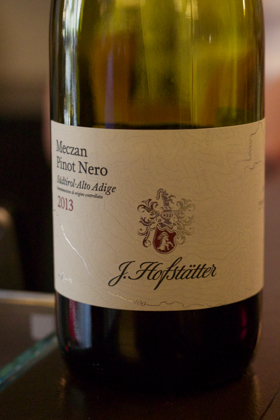
Meczan Pinot Nero
Meczan Pinot Noir
Made from Pinot Noir grapes of which 25% are left on the stem and placed whole into the fermentation tanks.
Pairing: Game dishes, roasts, pasta with meat sauces andbarley soup.
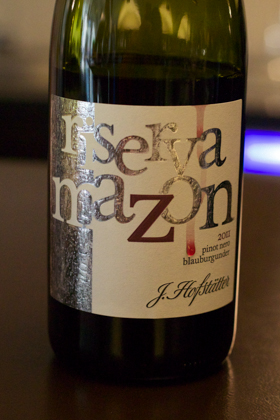
Mazon Pinot Nero Riserva Alto Adige
Mazon Pinot Nero Riserva Alto Adige
Made from Pinot Nero grapes grown on 30 year-old vines in the vineyard in Mazon. 25% of the grapes are left whole on the stem when put into the fermentation tank. The juice is aged in oak casks for 6 months.
Tasting notes: Jancis Robinson on the 2009 vintage tasted in 2013, “Very aromatic and ethereal after the much earthier Marsannays. Juicy and pretty without ersatz sweetness. Only a hint of coffee flavour. A fine example. Though just a tad dry on the end.”
Pairing: Red meats, lamb, poultry, game, and venison.
Timing: drink within 10 years
Rating: Jancis Robinson 16.5/20

J Hofstätter, Barthenau Vigna S Urbano 1995 Alto Adige
Barthenau Vigna S Urbano Alto Adige
Made from Pinot Nero grapes grown on 65 year old vines in the single vineyard, Vigna S Urbano in the Barthenau vineyard in Mazon. The Vigna S Urbano vineyard is considered by some to be the finest Pinot Noir vineyard in Italy. In producing the wine, 25% of the grapes are left whole on the stem when put into the fermentation tank. The juice is aged in oak casks for 14 months and then in large oak casks for 7 months.
Tasting notes: Jancis Robinson on the 1995 vintage tasted in 2011, “Planted in the 1980s and pruned pergola. Relatively dark ruby with some black notes. Age at the rim. Strange metallic note. Mid weight. Lots of acidity. And chew. Rather graceless and chunky. Losing fruit.”
Pairing: Red meats, venison and game, and mild cheeses.
Timing: drink within 10 years
Rating: Jancis Robinson 15.5/20
Merlot
Made from Merlot grapes.
Pairing: grilled meats
Cabernet Sauvignon
Made from Cabernet Sauvignon.
Pairing: Beef and lamb, game, venison and mature cheeses.
Kirchegg Merlot Cabernet Sauvignon
Made from 80% Merlot and 20% Cabernet Sauvignon grapes.
Pairing: roast beef, lamb, casseroles, game and mature cheeses.
Yngram
Made from 75% Cabernet Sauvignon and 25% Petit Verdot grapes from the prized single estate Yngram vineyard. It is aged for 12 months in small oak barrels and 7 months in large oak barrels.
Pairing: Venison, red meat and game.
Sparkling wine:
Classico Hofstätter
Made from 50% Chardonnay, 30% Pinot Blanc and 20% Pinot Noir grapes and produced using the Champagne method (Metodo Classico).
Barthenau Rosé – Metodo Classico
Made from Pinot Noir grapes and produced using the Champagne method (Metodo Classico).
Sweet wine:
Gewürztraminer Vendemmia Tardiva
Made from late harvest Gewürztraminer grapes which are pressed and aged in oak casks for 12 months.
Moscato Rosa
Made from Moscato Rosa grapes.
Pairing: Sweet desserts, especially chocolate tart.
J Hofstätter
Rathausplatz 7 | Piazza Municipio 7 39040 Tramin | Termeno (BZ) Tel: +39 0471 860161 http://www.hofstatter.comCellar visits by appointment. The wine tasting room can be visited without appointmen
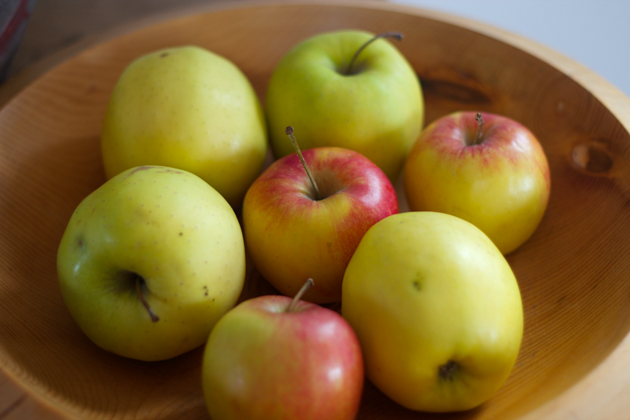
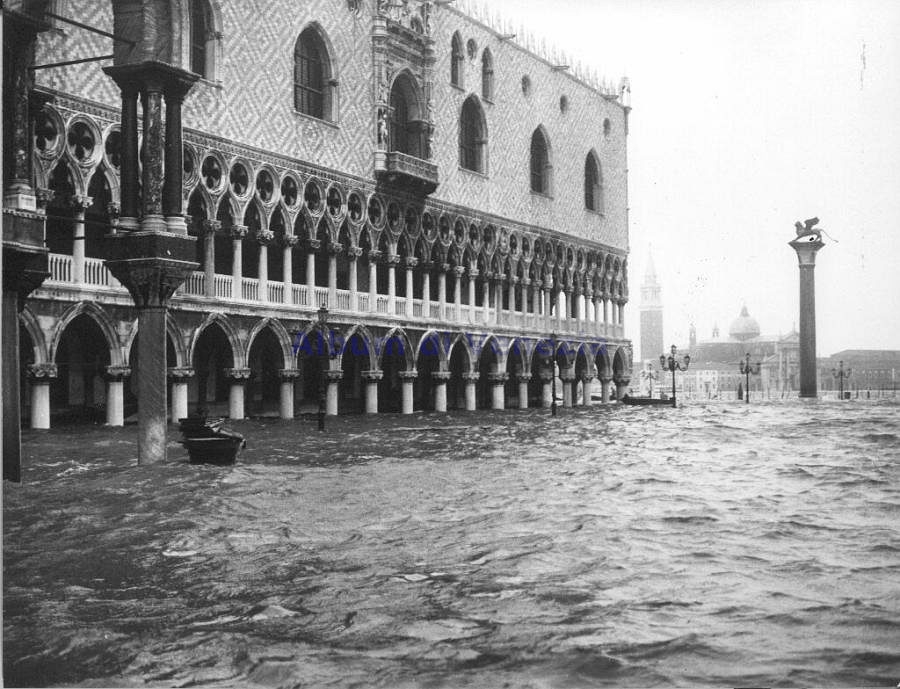
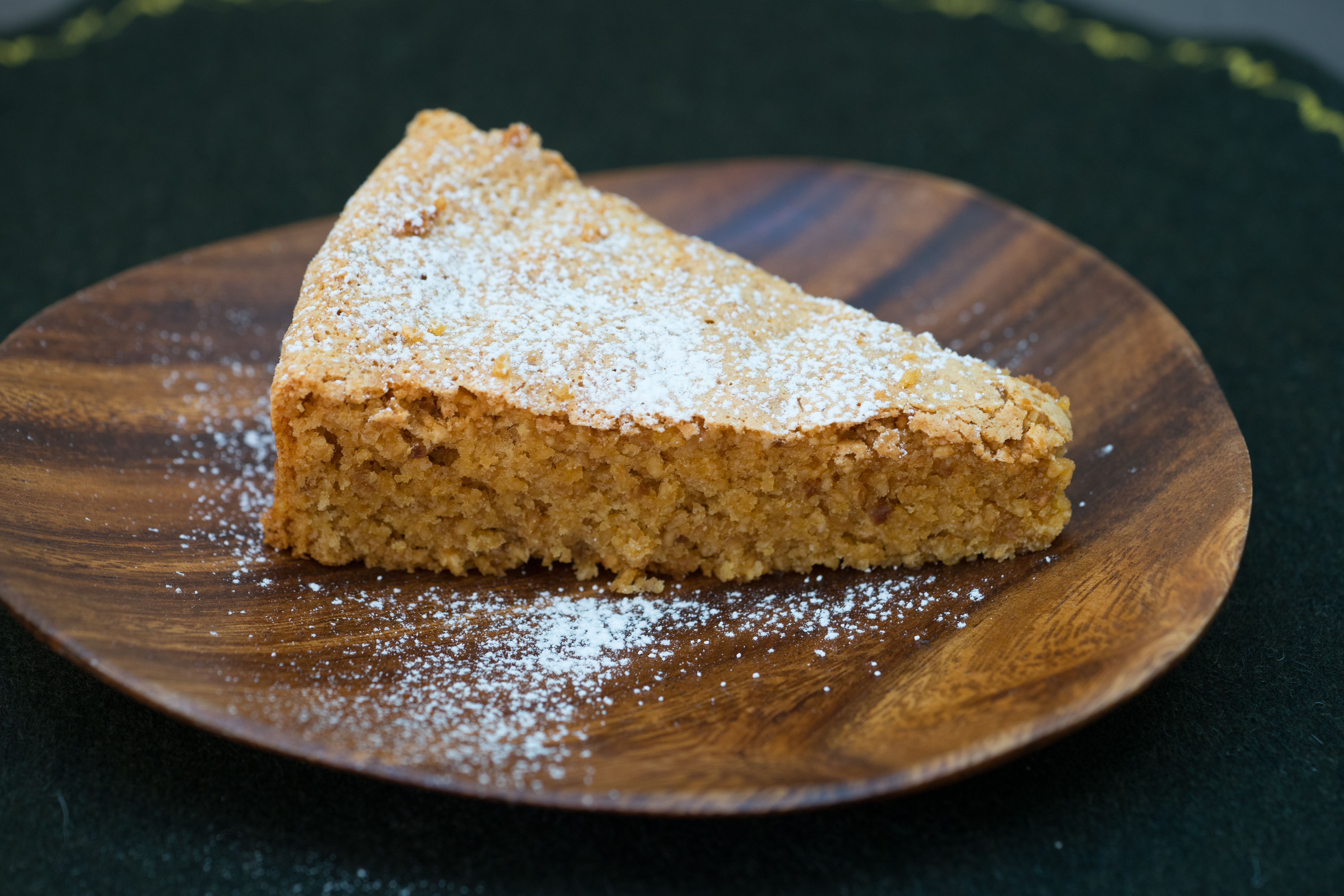
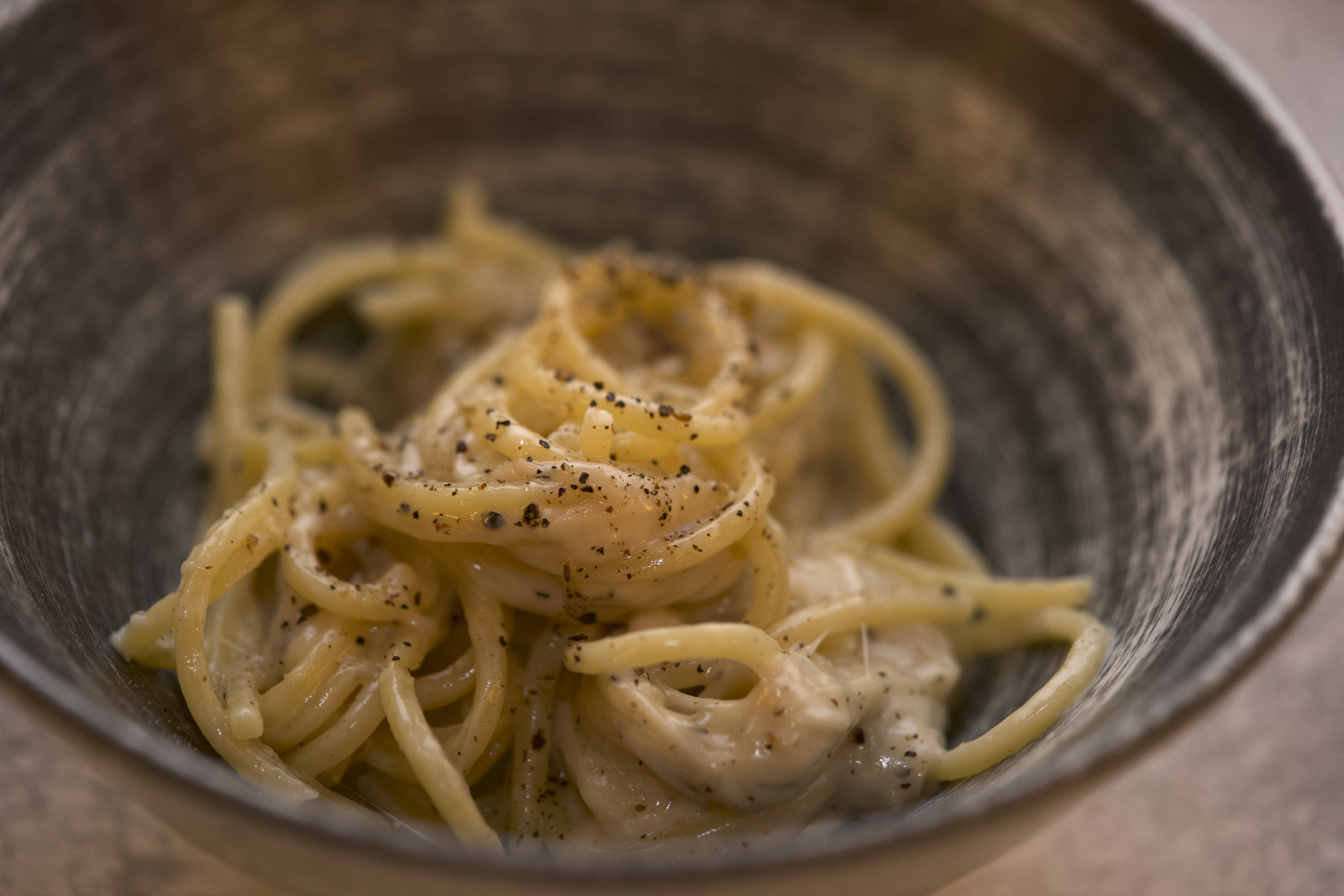
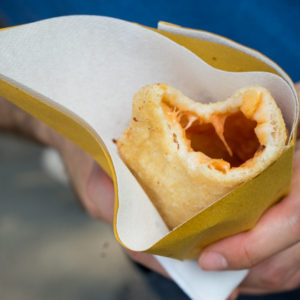
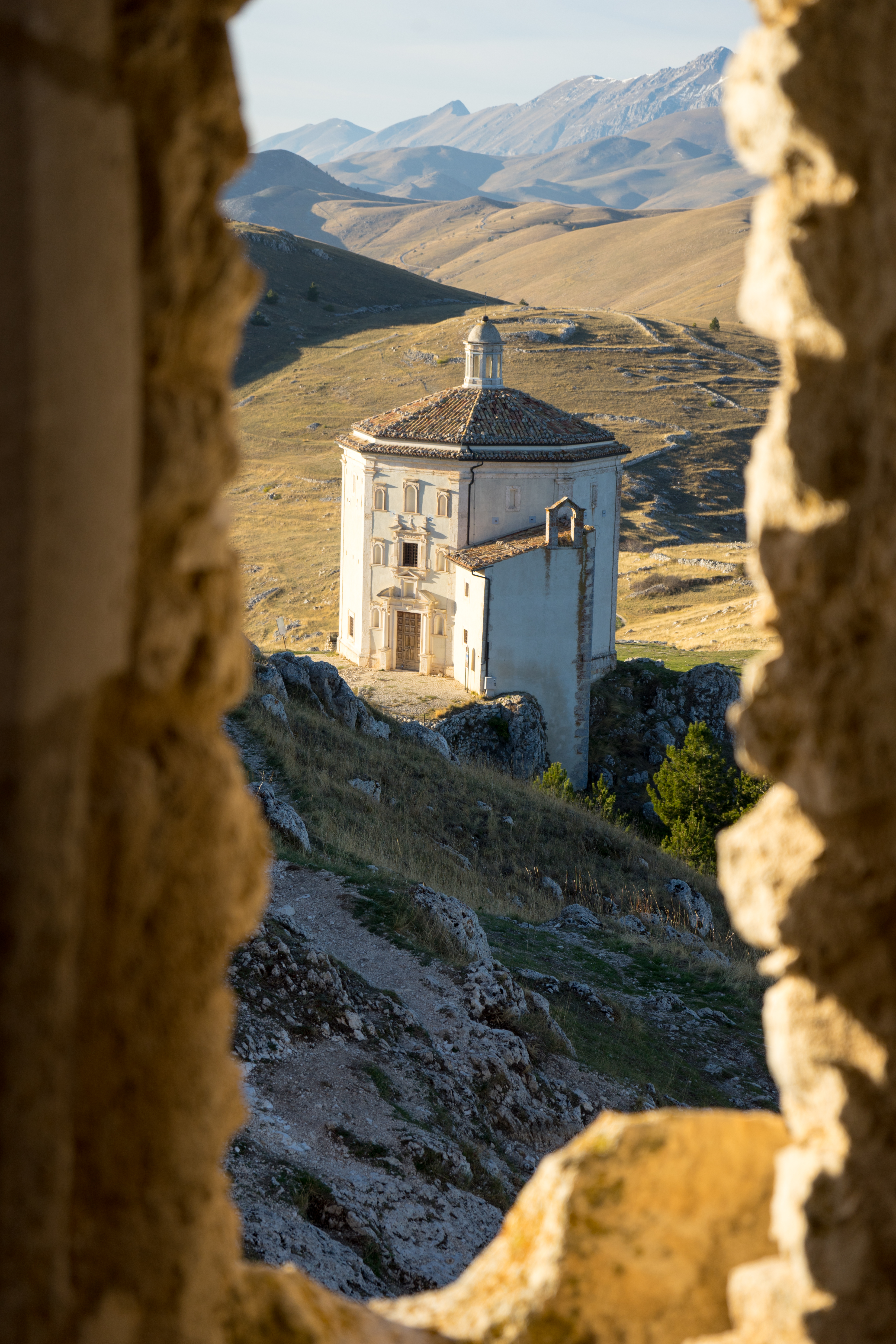
Leave a Reply